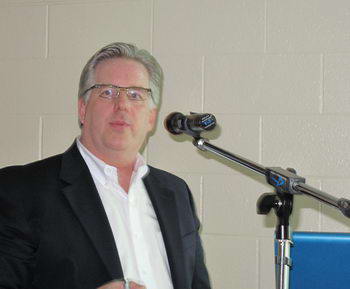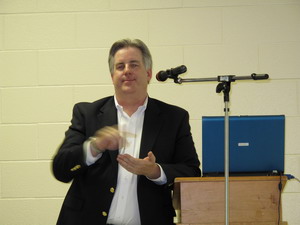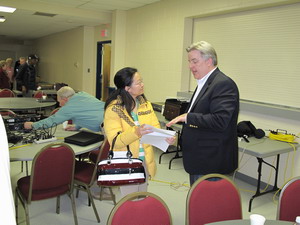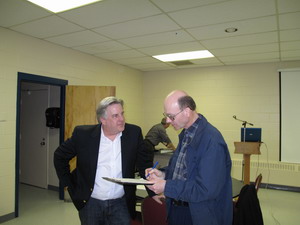
April General
Meeting
|
|
April 14th 2009
Us -Too! Brampton General Meeting
A
'state-of-the-art' presentation:
"Prostate
Cancer and Oxygen:
New targets and New Therapies"

by Dr. Robert Bristow
Dr. Bristow gave an excellent presentation to the 50 plus members
and guests focusing on the latest research in Prostate Cancer.

PSA test results and Gleason scores have long been the
benchmark to
determine whether patients require treatment and in turn which treatments
may be appropriate. Still, there have always been areas of uncertainty in
determining suitable treatments. Patients with low PSA & Gleason scores
may not require any immediate treatment, but some do develop more
aggressive forms of Prostate Cancer. Of those with similar PSA values and
Gleason scores most respond well to Radiotherapy while a few do not.
What was needed was a new tool to determine which
cancers may become
aggressive and which may respond well to certain treatments and not to
others.
In an extensive histological study of prostate glands, donated by surgical
patients,
a pattern began to evolve that may help to explain the differences between
aggressive and non-aggressive cancers and point the way to more effective
individualized treatment.
What they found in those patients with more aggressive
cancers were areas of
the prostate gland that were Hypoxic ( Poorly Oxygenated ). The greater
the
area of hypoxic cells the greater the likelihood that the cancer would be
aggressive and not respond well to Radiotherapy. This is due to the fact
that
Radiotherapy requires oxygen to be affective. In low oxygen environments
cancer cells are far more likely to survive treatment. It was also found
that
Hypoxic cancer cells were more resistant to Chemotherapy treatments as
well.
In studies that combined Hormone Therapy with
Radiotherapy it was found
that treatment results improved and this appears to be related to the fact
that
hormone therapy actually increases the oxygen levels of the prostate
cells.
Future studies and research will look at using this information to both
target
hypoxic cells within the prostate as well as further increase the oxygen
levels
in the prostate to limit growth and facilitate treatments.








The Talk was followed
by a detailed and lively Question and Answer session. Al Hutton's
emailed question on "Hyperbaric Chambers" was the first to be addressed by
Dr. Bristow folllowed by
numerous other questions from the audience.
AUDIO & SLIDES DOWNLOADS may be availed by clicking the links
provided below.
About Dr. Bristow:
Dr. Bristow has a brilliant background
with degrees, scholarships, awards, research, positions and
publications too numerous to list here. He is involved across a vast scope
of research activities and
programs both provincially and at international levels.
Amongst the key positions he holds currently are:
* Clinician-Scientist, Ontario Cancer Institute and Princess Margaret
Hospital (University Health Network)
* Associate Professor, Depts. Radiation Oncology and Medical Biophysics,
University of Toronto
*Director, Core I-STTARR and LEGEND Labs Canadian Cancer Society Research
Scientist
* Chair, Scientific and Medical Advisory Committee, Prostate Cancer
Research Foundation of Canada (PCRFC)
* Chair, Biomarkers Planning Committee, Canadian Prostate Cancer Research
Initiative (CPCRI)
* Full Member, Institute of Medical Science (IMS), University of Toronto
AUDIO & SLIDES DOWNLOADS
AUDIO:
Track 01:
Prostate Cancer and Oxygen - Talk
[13 Mbytes, Talk time: 00:55:32]
Track 02:
Prostate
Cancer and Oxygen - QA
[4.01 Mbytes, Talk time: 00:17:02]
SLIDES:
Prostate Cancer and Oxygen - Presentation slides
[Acrobat File, Size: 4.77 Mbytes, Pages: 39]
Our thanks to Dr. Bristow
for keeping us abreast of the
latest research in Prostate Cancer Treatment.
And as before it was real treat for us to listen to his high-
tech presentation and learn about the latest discoveries.
PROSTATE CANCER AWARENESS!
Prostate Cancer Canada Network - Brampton
·
Tel: 905- 453-3038 · Fax: 905-840-9474 · Email: info@pccnbrampton.com


